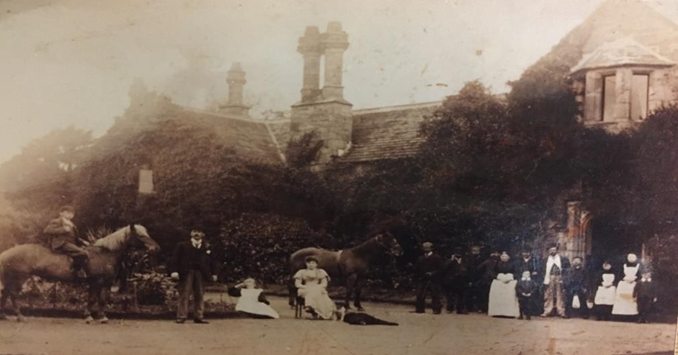The Bryngarw estate, with its beautiful house, formal gardens and picturesque lake, has a rich history dating back hundreds of years.
Historically, the Coytrahen Estate was under the ownership of the Powell family before being passed to John Popkin in the late 1700s. At the time of his death in 1798, John Popkin had no heirs and so bequeathed the entire estate to his sister, Frances – who, in 1775, had married Edmund Traherne of Castellau. Hence, the ceremony room being coined the ‘Traherne Suite’ in the present day Bryngarw House, which now operates as a wedding and events venue.
By the early 1800s, the estate had passed to Morgan Popkin Traherne, the third eldest son of Edmund and Frances (the eldest two sons having sadly died). It has Morgan Popkin Traherne who, in approximately 1830, built Bryngarw House as a gift for his recently widowed sister, Frances Jenner. In his Topographical Dictionary of Wales, written in 1833, Samuel Lewis noted: “Within half a mile of Coytrahen, a small but elegant residence has been erected, in the Elizabethan style of architecture, under the direction of Mr Traherne, for his sister, the widow of the late George Jenner, Esq. Of Doctors’ Commons.”
Frances Jenner resided at Bryngarw – originally referred to as Glan Garw – for forty years until her death in 1873, aged 92. At this time, the estate was owned by John Popkin Traherne, son of Morgan Popkin Traherne. However, John Popkin Traherne did not reside there, and so Bryngarw was leased to wealthy couples and families; its tenants included businessmen and colliery directors. Newspaper articles show an interesting insight into the layout of the House during this time. An advertisement in the South Wales Daily News in 1888 stated:
“To be let (furnished), Bryngarw House, close to a station on the Great Western Railway, and four miles from Bridgend, containing three sitting-rooms, seven bedrooms, and dressing room; good stabling, land if required.”
One of the families to take up lease was that of William John, managing director of Abergarw Brewery. One of the oldest photographs we have of Bryngarw House is of William, his family, and servants, standing for a portrait in around 1896.

During their time living at Bryngarw, Mr and Mrs John made a number of advertisements in the local papers both for sale of livestock and farm machinery, as well as servants such as a “groom-gardener”, laundress, livestock/farmer and lady’s maid – giving an insight into life in the late 1800s.
John Popkin Traherne died in 1901 and, having no heirs, the entire Coytrahen estate, including Bryngarw, passed to his nephew Captain Onslow Powell Traherne. Born in Bridgend and educated at Sherbourne, Onslow Powell Traherne was a stockbroker living in London when he inherited.
In the earlier years after he inherited, Onslow Powell Traherne very rarely resided at the estate and census records and newspaper articles reveal that Bryngarw House continued to be leased into the 1920s. During the time of the First World War, the house was occupied by a Mr & Mrs Llewellyn. Thanks to Welsh newspaper archives we know that Mrs Llewellyn was a big advocate for the local Red Cross Society, donating and raising funds to help the war effort.
Bryngarw House played an important role during the war: it was set up as a Red Cross Auxiliary Hospitral, known as Coytrahen Park Hospital, in 1915. It was Mrs Llewellyn’s intention to set up 30 to 35 beds for the wounded soldiers from the district and she proved to be a devoted leader of the hospital. In 1919, the Glamorgan Gazzette published an article recording that Mrs Llewellyn was “the recipient of a handsome present subscribed by the inhabitants of the district as a token of their deep sense of appreciation of her valuable services freely given … her devotion to the work of bringing comfort to the wounded soldiers under her charge.”
Although not necessarily living on the estate, Onslow Powell Traherne did make a number of changes to the grounds during the early 1900s. For example, the lake at Bryngarw was dug out from what was originally a marshy area fed by a small spring in the woods and was used for sport fishing and wildfowl hunting.
Between approximately 1910 and 1920 he used some of his wealth to extend the house and hired the highly regarded landscape designers Parsons, Partridge and Tudway to develop the Oriental Garden. As a young man he spent a good deal of time in foreign travel and was able to indulge in his lifelong interest in botany. He introduced many exotci plants and trees to the estate, such as the Japanese mapes, magnolias and rhododendrons, some of which still exist in the park today.
Onslow Powell Traherne lived at Bryngarw from the 1920s until his wife’s death in 1940, when he sold the Bryngarw Estate to a local businessman, Mr Hayes, and moved to a nearby cottage in Bettws. He remained in Bettws until his death in 1950, aged 84.
Mr Haynes and his family lived in the house until his death in 1959 when Bryngarw was acquired by the then Ogmore and Garw District Council for use as council accomodation. The house was converted into nine flats, and the estate orchard was removed to make space for 32 residential caravans.
In 1980, Ogwr Borough Council, now in charge of Bryngarw as a result of a local government reorganisation, designated Bryngarw a future country park, and in 1982, a five-year programme of reclamation and construction work began.
As part of this work, the formal gardens and lake were recovered, the caravans were removed to create a permanent car park, a network of paths was laid down and public facilities were built. Bryngarw Country Park was officially opened to the public on May 23, 1986, complete with a car park, toilets, cafeteria and children’s play area.
Over the past 39 years, Bridgend County Borough Council has continued to develop the park. In 1993 European funding was recieved to transform Bryngarw House into a hotel with 19 bedrooms with the addition of the conservatory, a restaurant. It was granted a license to hold weddings and has become a popular venue, also being used for conferences and private functions.
In 2012, a multi-functional visitor centre was opened. It contained a suite of public facilities including a display foyer, a classroom and events space, an office for the park rangers, a disabled toilet and a cafe.
Since 2015, the House and Country Park have been managed by registered charity, Awen Cultural Trust, in partnership with Bridgend County Borough Council. In 2021, the visitor centre was revamped and several new features were added, including a children’s willow den and storytelling area, a wellness area for rest and relaxation and displays detailing Bryngarw’s story.
In 2021, following a £750,000 investment by Welsh Government, as part of Valleys Regional Park, significant developments were made to Bryngarw Country Park including Y Nyth, a purpose-built education centre, outdoor natural play equipment, interpretation and signage, bike shelter, solar panels on the roof of the visitor centre & cafe, refurbishment of the outdoor public toilets and a sculptural trail.



